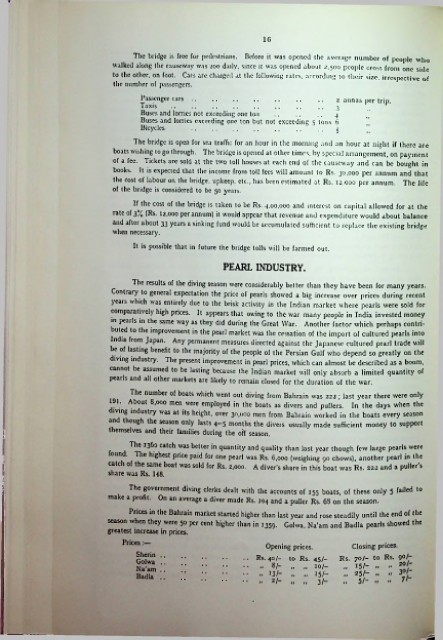Page 368 - Bahrain Gov Annual Reports (II)_Neat
P. 368
1G
The bridge is free for pedestrians. Before it was opened the average number of people who
walked along the causeway was 200 daily, since it was opened about 2,500 people cross from one side
to the other, on foot. Cars arc charged at the following rates, according to their size, irrespective of
the number of passengers.
Passenger cars .. 2 annas per trip.
Taxis .... „
Buses and lorries not exceeding one ton ........................4 „
Buses and lorries exceeding one ton but not exceeding 5 tons 6 ,,
Bicycles .................................................................i „
The bridge is open for sea traffic for an hour in the morning and an hour at night if there are
boats wishing to go through. The bridge is opened at other times, by special arrangement, on payment
of a fee. Tickets are sold at the two toll houses at each end of the causeway and can be bought in
books. It is expected that the income from toll fees will amount to Rs. 30,000 per annum and that
the cost of labour on the bridge, upkeep, etc., has been estimated at Rs. 12,000 per annum. The life
of the bridge is considered to be 50 years.
If the cost of the bridge is taken to be Rs. .4,00,000 and interest on capital allowed for at the
rate of 3% (Rs. 12,000 per annum) it would appear that revenue and expenditure would about balance
and after about 33 years a sinking fund would be accumulated sufficient to replace the existing bridge
when necessary.
It is possible that in future the bridge tolls will be farmed out.
PEARL INDUSTRY.
The results of the diving season were considerably better than they have been for many years.
Contrary to general expectation the price of pearls showed a big increase over prices during recent
" *,C 1 "?S. !ntlre,y due t0 tbe br*sk activity *n t*ie Indian market where pearls were sold for
para i\e y ig prices. It appears that owing to the war many people in India invested money
"7 “ the 531116 way as theV did during the Great War. Another factor which perhaps contri
buted to the improvement in the pearl market was the cessation of the import of cultured pearls into
t ,. °m 3pan' Any Permanent measures directed against the Japanese cultured pearl trade will
of lasting benefit to the majority of the people of the Persian Gulf who depend so greatly on the
^ T UStry‘ be Present improvement in pearl prices, which can almost be described as a boom,
not be assumed to be lasting because the Indian market will only absorb a limited quantity of
pearls and all other markets are likely to remain closed for the duration of the war.
mi ”Umber boats wb*ch went out diving from Bahrain was 222 ; last year there were only
j- • . ,U ,00° men "ere employed in the boats as divers and pullers. In the days when the
and th10 at *tS be,tbt' over 3°.°00 men from Bahrain worked in the boats every season
themselves and theiM ^d^ mon,tbs divers usually made sufficient money to support
! season.
found T,"Il6°.CatCh beUCr in ^uantity and quality than last year though few large pearls were
" f i u PnCC Paid f°r 0X16 t**Tl was Rs- 6*000 (weighing 90 chows), another pearl in the
share ^ ^ RS' 2'°°°' A diVer’S share in this boat was Rs* 222 and 3 Pu,,er'S
I
I make a profit. On an averag! a dfrwmld"T aCCOUnts o( '55 boats, of these only 5 failed to
cra8e a dlv<* made Rs. 104 and a puller Rs. 63 on the season.
when they were 50 peTcent^t started higher than last year and rose steadily until the end of the
season
greatest increase in prices ^lCr 1 an 1X11359- Gohva, Na'am and Badla pearls showed the
Prices:—
Opening prices. Closing prices.
Sherin .. . Rs. 40/- to Rs. 45/- Rs. 70/- to Rs. 90/-
Golwa .. .. 15/- .. 2° '
Na'am .. n n n 10 h .. .. .. 3.e
Badla .. • » 13/- „ „ 15 h
• .. 2/- „ „ 3/- n 5 /“ •*
-

